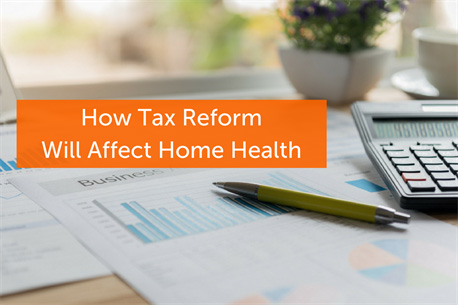For months, the Trump Administration’s efforts at tax reform dominated headlines, and much discussion in business in general. Now that the dust has settled, and the Tax Cuts and Jobs Act has officially been signed into law, it’s time to take a closer look at how the new rules will affect the home healthcare market.
Overall, industry insiders look at the tax reforms as a mixed blessing. There is good news and bad news, and as with any major overhaul, it will take some time to determine what the ultimate effects of this bill will be. Let’s take a closer look at what the TCJA could have in store for home healthcare.
The Good News
We’ll start with the good news: The tax reform bill will cut taxes for home health agencies. Beginning this year, the permanent tax rate for corporations will be 21 percent, down from 35 percent. According to the nonprofit, non-partisan Tax Foundation, this generally means that business will pay less taxes on their investment and labor, leaving more money for wage increases and job growth. Other industry analysts agree, noting that the reduction in the tax rate could lead to an overall increase in business value, with JP Morgan predicting that increase to be as much as 23 percent per share for publicly traded companies. In fact, the more leverage that a company has (in other words, the lower their debt rates) the better off they will be as a result of these changes.
Overall, financial analysts expect that the lower corporate tax rates will benefit the home healthcare market as a whole. Agencies will see an increase in cash flow, which will allow them to invest more money in their businesses; for example, they will be more likely to upgrade their home healthcare software. The reduced tax burden may also make it easier for agencies to comply with new CMS Conditions of Participation and other rules, which are projected to cost close to $300 million per year for some larger companies. Regardless of how the saving are reinvested, though, the new rules will undoubtedly result in a lower tax bill for agencies.
The Not-So-Good News
While it’s hard to argue that a 14 percent reduction in the corporate tax rate isn’t good news for a business, home health industry experts are concerned about other provisions of the new tax bill and the impact they could have on healthcare as a whole.
One area of particular concern is the potential for significant cuts to Medicare and Medicaid. In 2010, lawmakers passed a “pay-as-you-go” law, which could potentially lead to a $25 billion cut to these programs in 2020. While this could lead to a reduction in services overall, the home healthcare industry is particularly concerned about the potential that such cuts could have on reimbursement rates, especially if the growth spurred by the tax cuts is insufficient to offset such losses. With those concerns in mind, Senator Susan Collins (R-ME) has already been lobbying and drafting legislation to ensure that Medicare is spared from significant cuts in the future.
The tax reform bill also contains provisions related to itemized deductions and the Affordable Care Act that could affect home health. In terms of itemized deductions, the law puts new limits on how much interest agencies can deduct, which could be detrimental to those businesses carrying significant amounts of debt. At the same time, an amendment introduced by Senator Collins not only protected the deduction for medical expenses on individual returns, but lowered the threshold from 10 percent of income to 7.5 percent of income, so individuals with high medical costs should see a tax break.
As for the ACA, the reform bill eliminated penalties for those who do not have health insurance coverage. The version of the bill passed in the Senate repealed the individual mandate in its entirety, but the final version keeps the mandate but eliminates penalties — which could potentially have the same ultimate effect of individuals opting out of purchasing coverage. This could cause premiums to increase significantly to cover the shortfall, but there is legislation under consideration to increase funding to establish laws to prevent huge spikes in individual premiums.
Overall, the tax reform has some benefits and some drawbacks for the home health industry. For now, most industry experts are taking a “wait and see” approach, watching how the reforms play out in 2018. The discussions have not ended though, and they are likely to continue well into the coming years.
Keep watching this space for more news and updates on how this and other legislation will affect home health care, and don’t forget to check out our additional resources to learn how you can effectively manage your agency in this time of significant change and uncertainty.




